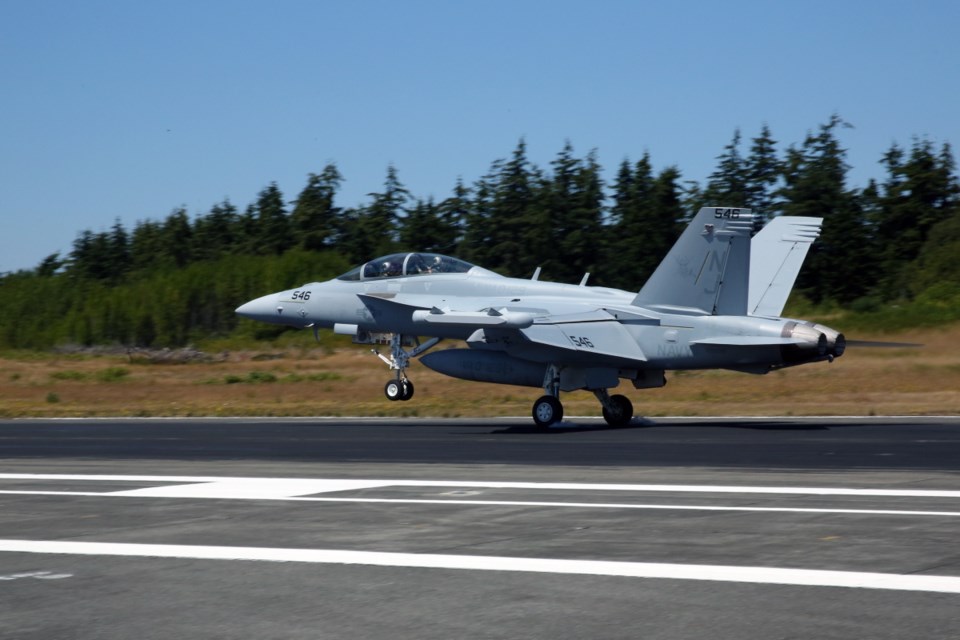The Rumbles returned this week, which means the Grumbles did, too.
OK, maybe not so much grumbles as a quick dive under the bed to brace for an earthquake that didn’t come, followed by a bewildered “What was that?”
The Rumbles are this strange sonic phenomenon — a low sound like God bowling or the beginning of a decent-sized quake — that occasionally rattles windows and nerves around Greater Victoria. It might feel like a big truck driving past. Dogs freak out. It lasts a few seconds, then stops, only to repeat — maybe — later.
The noise is most commonly associated with EA-18G Growler jets from the U.S. naval air station at Whidbey Island, Washington, about 50 kilometres southeast of Victoria. That’s backed up by where the sound is most commonly heard, in Oak Bay and the east side of the Saanich Peninsula.
It would make sense that we would hear the Rumbles now — social media lit up with reports from the Peninsula to Metchosin on Wednesday — since U.S. navy aircraft are taking part in Trident Fury 20, a Canadian-led training exercise that began Monday and continues through Dec. 13.
Except the Canadian military says no aircraft participating in Trident Fury 20 were operating around Victoria on Wednesday evening. “The closest was well off shore northwest of Tofino,” said Capt. Jenn Jackson, a naval public affairs officers aboard HMCS Regina. “We are not expecting to have any aircraft operating close to Victoria with the exception of some intermittent Cyclone operations later in the exercise.”
As for the Growlers, they aren’t even part of Trident Fury 20. The aircraft were taking off from Whidbey Island on Wednesday, but just like on any other day. “I don’t think they were flying any differently than they normally do,” said Tom Mills, a Whidbey Island base public affairs officer.
Mills gets the occasional call from Victoria about the Rumbles, but says he has never been able to match what the base’s EA-18G Growler electronic-attack jets are doing and what we’re hearing on Vancouver Island.
It could be a quirk of atmospherics, though, something about the strange ways in which sound travels under varying conditions. Changes to wind, cloud levels and so on can mean that sounds that are audible one day are muted the next. A jet that’s flying west might not be noticed until it turns east, exposing its exhaust. Sometimes aircraft need not even take off to be heard from afar; they just have to power up and down.
Noise associated with the Growlers was, in fact, at the heart of a protracted dispute between the U.S. navy and state and local officials who were worried about the effects of a plan to add up to 36 more Growlers to the 86 already based at Whidbey Island. In 2019 the navy decided to go ahead with the plan, though Mills notes that the additions will arrive over several years.
Basically, the navy decided that the upside beat the downside. The additional Growlers, whose role is to jam air-defence systems and communications, even block the enemy from detonating roadside bombs, reflect the expanding role of electronic warfare. The air crews need a certain level of training, which they only get at Whidbey Island, repeating touch-and-go landings to simulate what they do on aircraft carriers.
The need to train also drives Trident Fury 20. During Monday’s windstorm, it was possible, from the safety of the beach at Esquimalt Lagoon, to watch with bated breath a helicopter landing oh-so-delicately on HMCS Calgary as Juan de Fuca Strait heaved and waves exploded against the frigate’s hull. It was a good reminder not to moan about the rigours of your job.
We will moan about the Rumbles, though, at least until we understand them.



